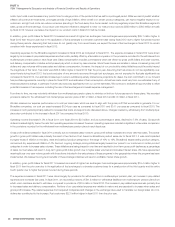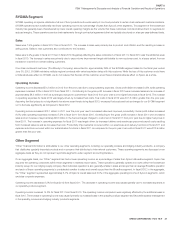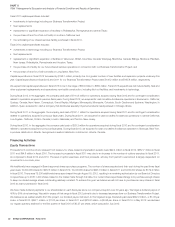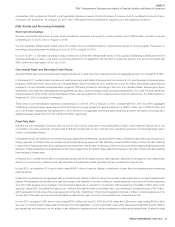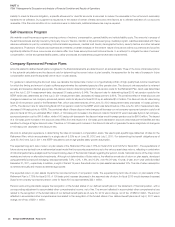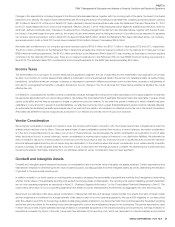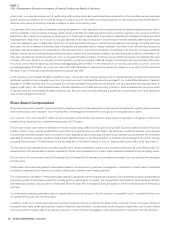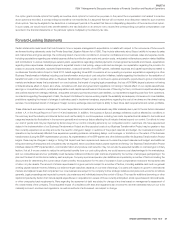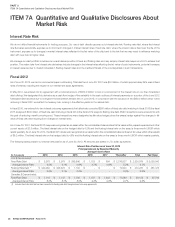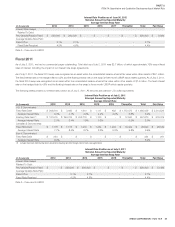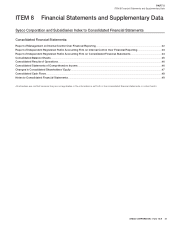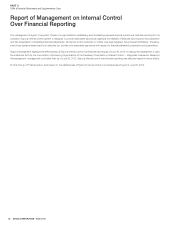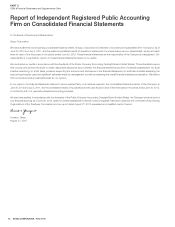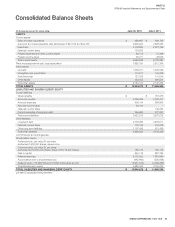Sysco 2012 Annual Report Download - page 58
Download and view the complete annual report
Please find page 58 of the 2012 Sysco annual report below. You can navigate through the pages in the report by either clicking on the pages listed below, or by using the keyword search tool below to find specific information within the annual report.SYSCO CORPORATION-Form10-K 35
PARTII
ITEM7Management’s Discussion and Analysis of Financial Condition and Results of Operations
Changes in the assumptions, including changes to the discount rate discussed above, together with the normal growth of the plans, the impact of actuarial
losses from prior periods, the impact of plan amendments and the timing and amount of contributions decreased net company-sponsored pension costs by
$27.3million in fi scal 2012. At the end of fi scal 2012, Sysco decided to freeze future benefi t accruals under the Retirement Plan as of December31,2012
for all U.S.-based salaried and non-union hourly employees. Effective January1,2013, these employees will be eligible for additional contributions under an
enhanced, defi ned contribution plan. Changes in the assumptions, including changes to the discount rate discussed above, together with the plan freeze,
the impact of actuarial losses from prior periods, the impact of plan amendments and the timing and amount of contributions are expected to decrease
net company-sponsored pension costs in fi scal 2013 by approximately $26.5million. Absent the Retirement Plan freeze discussed above, net company-
sponsored pension costs in fi scal 2013 would have increased $106.9million instead of decreasing $26.5million.
We made cash contributions to our company-sponsored pension plans of $162.4million and $161.7million in fi scal years 2012 and 2011, respectively.
The $140.0million contribution to the Retirement Plan in fi scal 2012 exceeded the minimum required contribution for the calendar 2011 plan year to meet
ERISA minimum funding requirements. The $140.0million contribution to the Retirement Plan in fi scal 2011 was voluntary, as there was no minimum required
contribution for the calendar 2010 plan year. There are no required contributions to the Retirement Plan to meet ERISA minimum funding requirements in
fi scal 2013. The estimated fi scal 2013 contributions to fund benefi t payments for the SERP plan are approximately $23million.
Income Taxes
The determination of our provision for income taxes requires signifi cant judgment, the use of estimates and the interpretation and application of complex
tax laws. Our provision for income taxes primarily refl ects a combination of income earned and taxed in the various U.S. federal and state, as well as foreign
jurisdictions. Jurisdictional tax law changes, increases or decreases in permanent differences between book and tax items, accruals or adjustments of
accruals for unrecognized tax benefi ts or valuation allowances, and our change in the mix of earnings from these taxing jurisdictions all affect the overall
effective tax rate.
Our liability for unrecognized tax benefi ts contains uncertainties because management is required to make assumptions and to apply judgment to estimate
the exposures associated with our various fi ling positions. We believe that the judgments and estimates discussed herein are reasonable; however, actual
results could differ, and we may be exposed to losses or gains that could be material. To the extent we prevail in matters for which a liability has been
established, or pay amounts in excess of recorded liabilities, our effective income tax rate in a given fi nancial statement period could be materially affected.
An unfavorable tax settlement generally would require use of our cash and may result in an increase in our effective income tax rate in the period of resolution.
A favorable tax settlement may be recognized as a reduction in our effective income tax rate in the period of resolution.
Vendor Consideration
We recognize consideration received from vendors when the services performed in connection with the monies received are completed and when the
related product has been sold by Sysco. There are several types of cash consideration received from vendors. In many instances, the vendor consideration
is in the form of a specifi ed amount per case or per pound. In these instances, we will recognize the vendor consideration as a reduction of cost of sales
when the product is sold. In some instances, vendor consideration is received upon receipt of inventory in our distribution facilities. We estimate the
amount needed to reduce our inventory based on inventory turns until the product is sold. Our inventory turnover is usually less than one month; therefore,
amounts deferred against inventory do not require long-term estimation. In the situations where the vendor consideration is not related directly to specifi c
product purchases, we will recognize these as a reduction of cost of sales when the earnings process is complete, the related service is performed and
the amounts realized. Historically, adjustments to our estimates related to vendor consideration have not been signifi cant.
Goodwill and Intangible Assets
Goodwill and intangible assets represent the excess of consideration paid over the fair value of tangible net assets acquired. Certain assumptions and
estimates are employed in determining the fair value of assets acquired, including goodwill and other intangible assets, as well as determining the allocation
of goodwill to the appropriate reporting unit.
In addition, annually in our fourth quarter or more frequently as needed, we assess the recoverability of goodwill and indefi nite-lived intangibles by determining
whether the fair values of the applicable reporting units exceed the carrying values of these assets. The reporting units used in assessing goodwill impairment
are our nine operating segments as described in Note21, “Business Segment Information,” to the Consolidated Financial Statements in Item8. The
components within each of our nine operating segments have similar economic characteristics and therefore are aggregated into nine reporting units.
We arrive at our estimates of fair value using a combination of discounted cash fl ow and earnings multiple models. The results from each of these models
are then weighted and combined into a single estimate of fair value for each of our nine operating segments. We use a 60% weighting for our discounted
cash fl ow valuation and 40% for the earnings multiple models giving greater emphasis to our discounted cash fl ow model because the forecasted operating
results that serve as a basis for the analysis incorporate management’s outlook and anticipated changes for the businesses. The primary assumptions used
in these various models include estimated earnings multiples of comparable acquisitions in the industry including control premiums, earnings multiples on
acquisitions completed by Sysco in the past, future cash fl ow estimates of the reporting units, which are dependent on internal forecasts and projected



